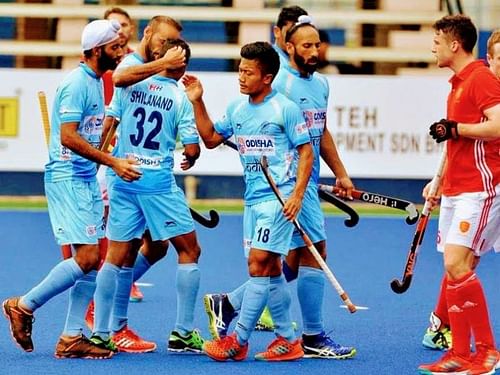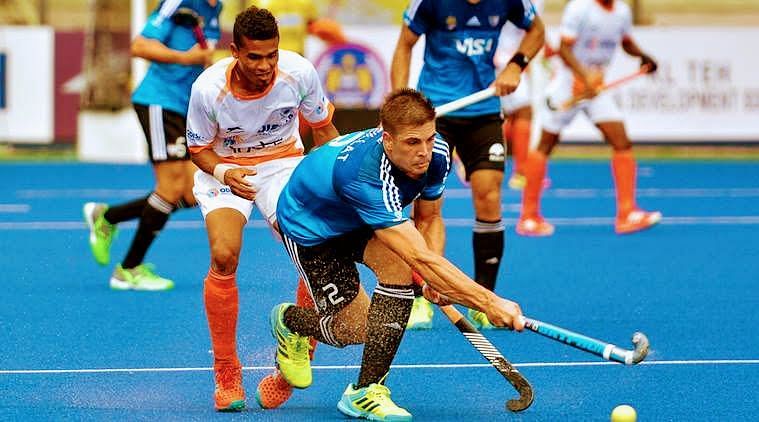
Azlan Shah Cup: Uphill task for India but youngsters give hope

India has a rest day today to ponder, reflect, and prepare for the rest of the Azlan Shah Cup tournament with three matches coming up next week.
India played both their opening matches at 1600 hours local time in hot and humid conditions and will enjoy a cooler setting on Tuesday with their match scheduled at 1800 hours. The opposition, however, will not be quite so cool in the form of world champions Australia.
India lost to Argentina 2-3 in the opener and drew with England 1-1 in their second match.
Commendable effort but not clinical
Playing fast, attacking hockey against Argentina, the Indian youngsters showed their class. The Olympic champions were accorded scant respect by India who penetrated the Argentine circle repeatedly but failed to score, partly because of some great saves by Argentine goalkeeper Vivaldi.
India lost 2-3, in a contest of penalty corners but managed to unsettle their higher-ranked opponents.

India broke the Argentine defence several times with clever, short passes and controlled possession for most of the match.
Inexperience in defence caused them to concede soft penalty corners and Gonzalo Peillat made them pay the price.
Against England, India played a solid defensive game.
They thwarted the advancing English forwards who made numerous penetrations into the Indian circle and managed to earn a draw.
For all of their efforts, however, India have just one point to show and with a match against the mighty Australians next on Tuesday, face an uphill task ahead in the tournament.
So, was coach Sjoerd Marijne right in not picking the seniors and experimenting with a new-look squad?
SV Sunil, India's speediest striker (who got married yesterday) along with Akashdeep Singh, Rupinder Pal Singh, Harmanpreet Singh, PR Sreejesh, and Manpreet Singh could not find a place in the team.
Short-term goals versus long-term objectives
It is not often that an Indian coach has had the luxury (or the nerve) to rest more than half the regular side for a major international tournament. Firstly, India didn't have requisite numbers and abundance of top-class talent which they do now to even envisage such a move.
Second, it needs firm determination and a steely resolve for a relatively new coach to leave his best players at home and try out a bunch of youngsters defying the expectations of an entire nation and a hockey federation looking for instant results. More so, if his predecessor was sacked for not delivering "short-term" results.
With regard to the sacking of Roelant Oltmans, this is what high-performance director David John had to say last year,
"We want to finish in top three in international events. We want to win the Asia Cup, Hockey World League Finals and Asian Games. We want to finish on the podium in Commonwealth Games, next years World Cup and 2020 Olympics."
Marijne has delivered so far. India won gold in the Asia Cup and bronze in the Hockey World League Finals last year playing their regular squad.
The Four-Nations Invitational in New Zealand was no doubt the platform to try out new combinations and experiment with a young side.
Abundance of talent
Most teams including Australia and England have fielded their best sides for the Azlan Shah Cup.
For Team India and their coach, however, the Azlan Shah tournament seems to be preparatory ground for the Commonwealth Games next month.
The victory of the Indian junior team in the World Cup in 2016 has seen a flood of new talent, knocking the doors of the senior national team and forcing the seniors to guard against complacency.
The message being conveyed is that even the most experienced players are not guaranteed a spot in the team and will have to perform at their best or lose out.
This is a ploy which other top sides in the world have used in the past, often "shielding" their regular team in the less important competitions. The purpose of this is two-fold.
The youngsters gain exposure at the highest level which does their confidence a world of good.
Also, the competing teams fail to get a measure of what the true potential of the regular squad is and therefore cannot formulate strategies against them for the bigger tournaments because the composition of the team changes significantly.
The challenge, however, is finding the right combinations, with multiple options to choose from Marijne will have to deliver on this count. The coach will be quite happy with the work done by the defense against England.
Discipline in defence
India's young defenders conceded soft penalty corners in the first match by lunging at the ball and engaging in needless tackles inside the circle.
They learned their lesson soon enough, however, and looked solid and resolute against England.
Disciplined, mature, and calm, the same players conceded just a single penalty corner in the second match.
Considering that England enjoyed a great share of the possession and made numerous penetrations into the Indian circle, the defenders have to be applauded for their ability to anticipate moves by the opposition and their quick interceptions.
Filling the penalty corner vacuum
Marijne's side came to Ipoh without the services of Rupinder Pal Singh and Harmanpreet Singh, the best drag-flickers in India currently.
Who would perform that role was the question and after a couple of matches the answer is still unclear. India failed to score from nine penalty corners against England.
Amit Rohidas did the trick in the match against Argentina, however, scoring twice off penalty corners against the world's second-best side.
Displaying great skill, he ensured that the vacuum created by the absence of Rupinder and Harmanpreet was filled at least partially.
India take on Australia on Tuesday and, needless to say, have to play out of their skins to challenge Colin Batch's side who are on top of the pool with six points.
Australia looked fearsome against England in a match that was played at a frenetic pace and also prevailed against hosts Malaysia.
If India manage to beat Australia, it will open up the tournament as Ireland and Malaysia are teams India should be able to handle.
That is easier said than done, however, as India has to iron out several flaws including getting their drag flicks right. The defence who have excelled in the match against England will face a much sterner test against the lightning-quick Australians who have scored seven goals in their two matches.
So, follow the action on Tuesday as Sardar Singh's side will look to upset Australia in a must-win encounter for India.